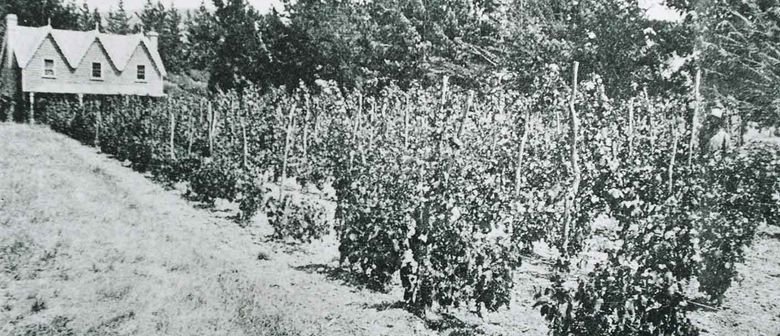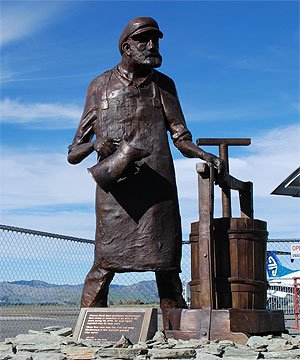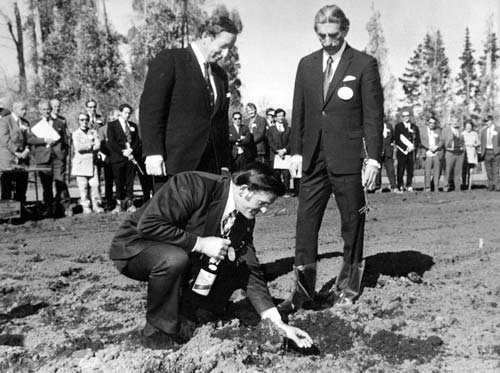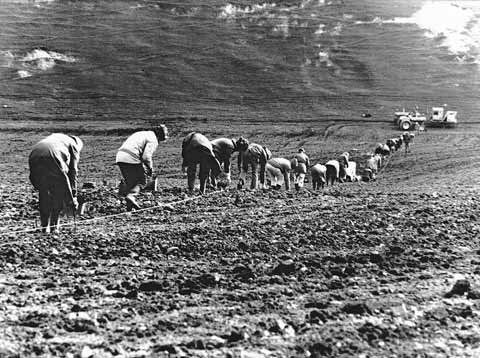Marlborough’s Wine History
Marlborough’s Wine HistoryWritten by Tessa Nicholson, Editor of New Zealand Winegrower Magazine.
It is hard to imagine the Marlborough landscape without hundreds of thousands of vines. But it hasn’t always been this way. In reality the march of vines across the plains and gently sloping hills of the region only began back in 1973. Prior to that Marlborough was better known for its abundance of sunshine and its production of barley and lucerne. No one could have imagined that a little known wine company based in Auckland would change the face of Marlborough forever.
These days those original few hundred hectares of grapes have multiplied into thousands. There is hardly a flat piece of land that hasn’t been taken over by vines and the ensuing wines have made Marlborough a tour de force within the wine world.
There were signs that this region at the top of the South Island had the ability to produce wine well before the first commercial plantings in 1973. In fact exactly 100 years earlier two men pioneered grape growing and wine making in Marlborough, albeit on a very tiny scale.
David Herd owned a block of land in the Fairhall area which he called Auntsfield. He purchased the land from the Rev Charles Saxton who held the Crown Grant but had never taken possession. In 1873 David Herd planted a small block of vines on the land. The grapes he planted were a brown mutation of Muscat Petite Grain commonly called Brown Muscat at that time. David Herd made wine until his death in 1905. His son in law Bill Paynter took over Auntsfield and continued making the wine, until 1931. These days the predominant varieties produced in Marlborough are Sauvignon Blanc, Pinot Noir and Chardonnay with small amounts of Riesling and Pinot Gris. However in a remote corner of Fairhall a small vineyard containing Muscat vines celebrates the memory of David Herd’s early vineyard.
Auntsfield Estate
The statue that stands at Blenheim Airport created by sculptor John Fuller based on an old photograph was commissioned by the Cowley family, current owners of Auntsfield Estate, a modern vineyard on the original site, close to the Blenheim Airport.
Fast forward 100 years after Herd produced his first vintage and there were no vines left in Marlborough. Montana which was the country’s largest wine producer was looking to expand its portfolio. Founder Frank Yukich desperately wanted to move the company away from just bulk wines and into wines for export. But just where he was going to do that wasn’t so clear. Montana already had substantial holdings in the North Island, but land prices were high in all the “proven” wine regions. Frank decided the company needed to look further afield and gave the task of finding a suitable location, to the company’s viticulturist Wayne Thomas. After months of research Wayne came back with a detailed report citing Marlborough as the region with the best potential for wine growing.
With incredible secrecy the two men made plans to visit the region and see if they could purchase large tracts of land without letting on to anyone what it was intended for. They arrived in Marlborough and met with John Marris who at the time was a stock agent for Pyne Gould Guinness. Keen to get into real estate, he jumped at the opportunity to secure a deal for the two men, who were trading under the auspices of Cloudy Bay Developments. When asked if he could locate up to 1200 hectares within a 24 hour period, he didn’t flinch. In fact within the incredibly short time frame he had unearthed a potential 2900 hectares, of which Montana settled on 1173. Before anyone could find out his true motives, Frank made a 10% non refundable deposit on the land and then returned to tell the Montana board what he had done. According to Frank the board wasn’t exactly over the moon with his decision and turned down his proposal to develop a vineyard in Marlborough. It was tenacity on his behalf that ensured the land sales went ahead. Certain that Wayne’s report was thorough and correct, he asked his viticulturist to get a second opinion from Professor Harold Berg from University of California Davis, a world expert on Oenology and Viticulture. Wayne did even better, he got not only Berg to read his initial report, but also two other leading authorities. All three signed a collective statement that Marlborough had the best potential for grape growing in New Zealand for the following reasons:
Maximum sunshine
Minimum rainfall (especially during vintage)
Free draining soil of medium fertility
Freedom from seasonal frosts
The backing of such leading Oenology experts changed the mind of the Montana board and the land buy up was finally approved. In total Montana paid $1,343,425.00 for the 1173 hectares – an average of $1146.00 a hectare.
But still there was no indication what this secret buy up was for. Rumours began that someone from out of town wanted land to develop lucerne production, a giant wheat farm and a thoroughbred horse stud. But grapes? No way, they never came into the equation.
Before long though, the cat was out of the bag and it became apparent that the large tracts of land had been bought by a wine producing company, very few people in Marlborough had ever heard of. Grapes in Marlborough? You must be kidding! That was the general opinion on the street. After all this was the era of gin and tonic and flagons of beer. Wine was a little known commodity.
There was much amusement and curiosity when Montana began developing its first vineyard – now known as Brancott Estate. The land was cleared and levelled, and the first of thousands of vines was planted on August 11, 1973. At the ceremony, Frank Yukich made the statement that “Wines from here will become world famous.” At the time, no one took him seriously.
Frank Yukich of Montana Wines places a silver coin, a token of good fortune, in a hole in which a vine is to be planted, in 1973. Standing behind him is Montana chair David Beattie, later to be governor-general.
In the months that followed, the statement seemed even more ludicrous as a number of disasters nearly thwarted Montana’s plans.
Whereas today there are nurseries to provide rooted vines, back in 1973 Montana didn’t have the luxury of such innovation. Instead they took cuttings from their Gisborne vineyards and attempted to grow them in the parched soils of Brancott.
Disaster number one. There was no way the tiny sticks could take root and despite the efforts of staff trying to manually water them, almost 70 percent died in the first few months.
Someone came up with the idea of placing wax cones over the vines, to protect them from heat and the soil from evaporation. School children helped with the project with all 800,000 vines covered with the cones.
Disaster number two. Marlborough is renowned for its north westerly winds and the summer of 1973/74 was no exception. As soon as the winds began, the cones took flight, scattering against fence lines and travelling for kilometres over the bare land.
By 1974 Montana had learnt its lesson and the first of the potted grapevines arrived. From there on the wine industry took hold in Marlborough. The company would continue to expand its holdings and experiment with new varieties eventually trialling Sauvignon Blanc at the Brancott Estate. The prophetic words of Frank Yukich would go on to be remembered as this variety took Marlborough’s name to the world.
But while Montana was the first to place its faith in the region, there have been many others that have helped secure its reputation. And it hasn’t always been an easy road to success.
Take the plantings of vines outside of the Brancott and Fairhall districts for example. In the early 70s Central Government had decreed that all local councils had to produce a District Scheme Plan, which had to be open to public scrutiny. The Marlborough County Council (which was the administrator of rural regions outside of the Blenheim Borough) had produced their plan. And it wasn’t too favourable to anyone wanting to grow grapes. As it had come into effect after Montana had begun planting on the southern side of the Wairau Plains, there was little the Council could do to prevent that. But they did place a condition within the District Scheme that prohibited any grape growing north of Old Renwick Rd. This is the area known as Rapaura, which has gone on to become one of the most famous of Marlborough’s subregions. When Chris and Phil Rose wanted to become contract growers for Montana in 1975, they were stymied by the Council regulations to say nothing of their neighbours who were extremely anti the thought of grapes in their neighbourhood.
The objections were vociferous and ranged from the moral issue, (growing grapes to produce alcohol was a sin) to forestry interests who were worried their livelihoods were at risk, to local farmers who felt the new industry would impact on their ability to continue farming as they had for years. The couple fought long and hard for the right to plant grapes and finally in 1978 won their battle. It opened the door for others in the Rapaura area to move into the wine industry. And move they did.
One of the first to do so was Ernie Hunter, an Irishman who had purchased 26 hectares right in the heart of Rapaura. With the gift of the gab and ability to market, he let nothing stand in his way when it came to promoting his wines. He is renowned for taking his Fumé Blanc to The Sunday Times Vintage Festival, (the first ever Marlborough wine accepted for the prestigious competition) in 1986. Of the 350 pre selected wines, from 13 countries, Hunter’s Fumé Blanc was awarded a gold medal for the best non‐Chardonnay full dry white wine of the show. Three separate groups of Sunday Times Festival club members also voted his wine as their favourite. It was a rout and one that brought Marlborough’s name to the wine world.
Hunter’s would go on to win the same award three years in a row, unheard of in the history of the competition.
Those wins coincided with the emergence of another boutique winery in Marlborough – Cloudy Bay. The brain child of Australian David Hohnen, Cloudy Bay was to become an iconic Marlborough wine company. Following the lead set by Montana, and Hunter’s, Cloudy Bay produced a Sauvignon Blanc that took the world by storm. Once they began exporting, particularly into the UK, they received rave reviews. The ground set by the first few founders of Marlborough’s wine industry was helping to establish the region as the new darling of the wine world.
Ernie Hunter established Hunter’s Wines in 1979. The vineyard’s sauvignon blanc won awards at London wine festivals in the mid-1980s. After Ernie died in a car crash in 1987, his wife Jane took over the reins. She had been appointed to the Order of the British Empire (OBE) and made a Companion of the New Zealand Order of Merit (CNZM) for services to viticulture.
Kevin Judd, the winemaker for Cloudy Bay winery from its first vintage in 1985, inspects a glass of 1994 sauvignon blanc. Judd gained an international reputation for Cloudy Bay sauvignon blanc. In 2009 he set up Greywacke winery, also based in Marlborough.
In 1985 though, troubles were brewing for the New Zealand wine industry overall.
Marlborough wasn’t immune to those troubles and when it was decided that a glut of wine was threatening everyone, the Government agreed to fund a vine pull. The aim was to cut New Zealand’s vineyard area by a quarter, with growers to be paid $6175 for every hectare of grapes they removed. Many of the stalwarts of the industry believe this was the making of Marlborough, as it allowed growers to pull out their less desirable varieties and replace with more marketable ones – such as Sauvignon Blanc and Chardonnay. While the Government paid growers to pull vines, they placed no restrictions on new plantings, meaning many growers took the money and used it to replant with consumer led varietals.
Another significant event in the development of Marlborough’s wine industry was the discovery of Phylloxera in the region. Phylloxera is a grapevine disease that spreads quickly, has no cure and eventually causes the vines to shut down. The only solution is to replace the infected vines with Phylloxera tolerant rootstock. While it was a massive blow to the local industry, it again gave growers and wine companies the opportunity to rethink what they wanted to be producing. Many believe without these two major events, Marlborough could still be growing bulk varieties like Muller Thurgau and Chenin Blanc.
From such small beginnings back in 1973, Marlborough has quickly grown to be New Zealand’s largest producer.
Originally most of the vineyards were producing bulk varieties such as Muller Thurgau. These days Sauvignon Blanc is the most important variety in terms of volume, but it isn’t the only star to emerge. Pinot Noir production has increased dramatically in recent years, not only for table wine but also for bubbles.
Chardonnay is the third most popular varietal grown, followed by Pinot Gris and Riesling. The full fruity, zingy flavours Marlborough Sauvignon Blanc has become renowned for are also imparted within the aromatics that have emerged as leading players.
So why is it that Marlborough is such a world class producer of wine?
One of the key ingredients to the unique flavours is the (diurnal) temperature variation between day and night. Marlborough enjoys long periods of hot, dry days during the ripening stage combined with cooler night temperatures. It is normal for the temperature variation to be around 10 deg C, between day and night. This allows the grapes to build the brix levels during the day, with the high level of fruit acids being retained with the cooler night time temperatures.
With normally long, dry autumns, fruit can usually be left on the vines for a long period, without sacrificing the acidity that delineates wines from the region.
Added to that the soil types throughout the region offer something special to the wines. There is no one word you can use to describe the soil types, other than to say they are variable. Close to the major rivers in the Wairau Plains the soils range from stony former riverbed gravels to deep fertile silts. Move further south to the Awatere Valley and again you see a variety of soils, from older loess to mixed stony gravel. It is not unusual to see a variety of three different soil types within a small 4ha vineyard, with each offering something different to the end product. More and more companies are now utilising those differences, with single vineyard wines that capitalise on the unique conditions of individual winegrowing districts.
Originally the Wairau Plains were the home of all the region’s vineyards, with the exception of Vavasour Wines which began planting in the Awatere way back in 1986.
These days though there are vines wherever you travel in the region. From the moment you enter Marlborough from the south, you encounter vines. Travel to the west and the vines march steadfastly towards Lake Rotoiti. The same can be said about the north and east of the region. What’s more the wine industry has played a major role in the economic prosperity of Marlborough. The incredible expansion of the wine industry in recent years has been the backbone of that economic growth.
So where to from here? It would be interesting to be a fly on the wall of Marlborough in another 150 years, to see just how much more revered this region is as a wine producer of quality.









